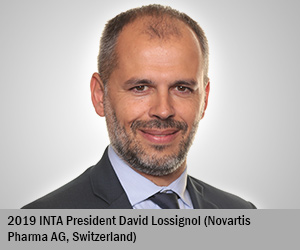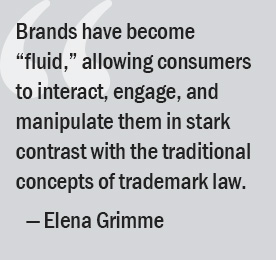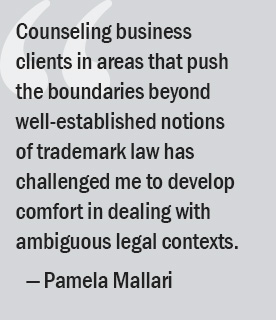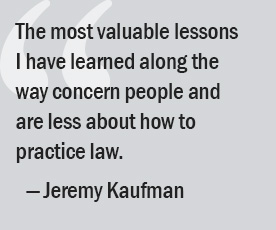2019 INTA President David Lossignol: It’s Our Job to Show How Brands Make Life Better
Published: March 1, 2019
 As Head of Trademarks, Domain Names and Copyrights at Novartis Pharma AG in Basel, Switzerland, and now as 2019 INTA President, David Lossignol has a lot on his mind. In addition to his responsibilities at Novartis, Mr. Lossignol is taking on the formidable challenge of helping to transform the way brand owners, trademark professionals, and consumers think about trademarks and brands.
As Head of Trademarks, Domain Names and Copyrights at Novartis Pharma AG in Basel, Switzerland, and now as 2019 INTA President, David Lossignol has a lot on his mind. In addition to his responsibilities at Novartis, Mr. Lossignol is taking on the formidable challenge of helping to transform the way brand owners, trademark professionals, and consumers think about trademarks and brands.
Much of the conversation focuses on ways to counter anti‒intellectual property (IP) sentiment, to reduce demand for counterfeits, and to more effectively communicate the dangers of brand restrictions, as well as to embolden trademark and brand lawyers to start viewing themselves as business partners, instead of approaching trademark work as just another box to check on the list of steps in a brand protection strategy.
Now an INTA member for 16 years, Mr. Lossignol has seen the Association take the lead on many of the most pressing trademark issues of his time on a global scale. He spoke with the INTA Bulletin about how he plans to further those efforts during his presidency and what belonging to INTA has meant to him.
What issues do you plan to prioritize during your year as president?
There are a few big ones. Anti-IP sentiment is growing, and, even though it’s something that is usually aimed more at patents and copyright than trademarks, it contaminates trademarks and brands. IP should be seen as a source of innovation, so we need better messaging to counter that.
Another issue that follows from that is brand restrictions. If you’re anti-IP, you don’t hesitate to restrict IP rights. Tobacco is the main target of brand restriction legislation in an increasing number of jurisdictions, but it’s no longer limited to that sector. Now, brand restrictions touch pharmaceuticals, food and beverages, and almost any product that can be perceived as somehow unhealthy. We have to tackle that issue as an Association and ensure that we’re efficient in our approach to educating the public about the positive aspects of brands; for example, how restricting or eliminating trademarks and logos on packaging can actually increase the dangers to consumers because of a greater threat of counterfeit goods and services.
 That’s what the Presidential Task Force I’ve created is aimed at. It’s called “Brands for a Better Society.” Its goal is to show how brands help society at large by focusing on what brands are bringing to communities and by moving beyond the traditional message that trademarks merely protect corporate interests. We want to remind people how trademarks help to communicate quality and support corporate social responsibility (CSR) efforts, for instance. Many brands are really working hard for their communities and doing a lot to help local producers and consumers, or simply people in need. We should illustrate this and do more to advertise the positive efforts of the brand community.
That’s what the Presidential Task Force I’ve created is aimed at. It’s called “Brands for a Better Society.” Its goal is to show how brands help society at large by focusing on what brands are bringing to communities and by moving beyond the traditional message that trademarks merely protect corporate interests. We want to remind people how trademarks help to communicate quality and support corporate social responsibility (CSR) efforts, for instance. Many brands are really working hard for their communities and doing a lot to help local producers and consumers, or simply people in need. We should illustrate this and do more to advertise the positive efforts of the brand community.
A recent survey about younger consumers shows that they need to feel connected to the brands they choose, so brands must spend time collecting company data and messaging around the positive work brands do and how society benefits in return. Consumers want to see brands as being about more than just profits. Trademark-intensive contributions are crucial; they provide a huge number of jobs, both directly and indirectly, so it shouldn’t be very hard to communicate this.
How will the Task Force approach this?
We want the Task Force to come up with actionable recommendations that will help brands that are currently and actively engaged in CSR to advance those efforts and help brands that aren’t already doing these things to take up new initiatives. The Task Force membership is very diverse in many aspects, but what they share is a desire to better society. Being diverse and society-oriented are the keys to developing messaging that will resonate across all demographics. Investing in making the world a better place should be boosted and highlighted further. It is a win for humanity.
What other challenges do you want to tackle?
Another priority of mine is anticounterfeiting. We especially must work on education to make counterfeits socially unacceptable and to reduce demand. We have to let people know the links between counterfeiting and crimes like terrorism and drugs, and change the messaging so that demand for counterfeits is minimized and criminals no longer see it as profitable.
Why do you think counterfeiting has become so prevalent?
Two reasons-it’s profitable and there’s less risk than in other illicit businesses. There’s a lot of effort to fight counterfeits, but online sales have contributed to the spread from producer to consumer more quickly and directly. The parcels are smaller and more spread out now, so it’s also harder for brand owners to fight it.
We must adapt, and legislation has to be improved so that sanctions for counterfeiting are higher; that’s not a quick process. We also need laws that will enable us to find out who is behind illicit websites. The European Union’s General Data Protection Regulation, for instance, has made it nearly impossible to find out who’s behind some of these websites. That has to be sorted out.
How has the scale of these issues changed the role of trademark professionals over time?
You can no longer be just a trademark attorney; you must be a brand-oriented attorney. This applies to both in-house and outside counsels. Marketing and advertising laws are very important for IP attorneys to understand today. Everything is connected now, and we often are the link between all of the different internal departments. Companies must be more integrated.
 As an in-house brand attorney, you don’t need to be an expert in everything, but you do need to know at least the basics about areas like privacy and marketing, and other in-house associates or outside counsels must be capable of advising in a more in-depth way in those areas. The role of in-house counsel now is to work more collaboratively, rather than in silos. It’s important to be more cross-functional. You can no longer be a lawyer sitting in the corner disconnected from your internal clients and working abstractly; you have to be a business person who happens to have a legal background. More and more, that’s what’s being asked. It’s a different mindset, and the trend is increasing.
As an in-house brand attorney, you don’t need to be an expert in everything, but you do need to know at least the basics about areas like privacy and marketing, and other in-house associates or outside counsels must be capable of advising in a more in-depth way in those areas. The role of in-house counsel now is to work more collaboratively, rather than in silos. It’s important to be more cross-functional. You can no longer be a lawyer sitting in the corner disconnected from your internal clients and working abstractly; you have to be a business person who happens to have a legal background. More and more, that’s what’s being asked. It’s a different mindset, and the trend is increasing.
The business expects added value, but we can’t forget that IP should also contribute significantly to preserving brand reputation. We have a big role to play in communicating this information to consumers.
What can outside counsel do to ensure they’re keeping up?
Today, companies want their outside counsels to be business partners and not simply service providers. Outside counsels need to sit down with clients and really understand the issues they’re facing. They have to be agile and customize their offerings according to clients’ needs.
This may be more difficult for some of the larger firms since their structures are sometimes less flexible and they are hesitant to take on the risk of advising outside of their comfort zones or traditional reporting structures. But today, companies want more customization, whether it’s outside counsels or vendors. Rigidity and traditional models are not useful.
What other issues do you think are most on INTA members’ minds these days?
Brexit, of course. The situation isn’t necessarily chaotic from an IP sense, because we have guidance from the United Kingdom on what’s going to happen, but a “no-deal” scenario will affect a lot of UK practitioners in terms of where they will be able to represent clients, for instance. We won’t know all the effects until the situation is upon us.
As an Association, INTA’s role is to get all the questions answered. At our 2019 Europe Conference: Embracing Change last month, for instance, Kate O’Rourke, president of the Chartered Institute of Trade Mark Attorneys, answered many questions about Brexit for attendees. It was very practical. We aim to do more of that for our members and for the IP community in general. The 2019 March Conference: The Business of Brands in New York in March will emphasize practical business and legal issues in the same manner as well.
IP rights in China is also very important, and we have seen some progress there. If you look at the starting point compared to now, the government has made significant efforts in the last few years. The proposed fourth revision of the Chinese Trademark Law was announced in April 2018, and it is expected to come into effect between 2022 and 2025. It will focus on issues including shortening trademark registration and opposition, emphasizing trademark use, and tackling trademark stockpiling and piggybacking.
We are monitoring it closely. INTA has a delegation to China every year, and we’re highly respected by the authorities there as an Association. We’ve become a very strong partner of the authorities. These relationships took a long time to build, but now that we have them in place, we have the opportunity to communicate our positions effectively.
Are there any trademark issues that are unique to your practice in the pharmaceutical sector?
Parallel imports are a big issue in our sector. It’s even more prominent now because of the Falsified Medicines Directive, which just entered into practice in February. Parallel trade in pharmaceuticals is potentially a huge safety risk to patients; it’s something we monitor very closely.
Also, review of drug names by the health authorities is a big part of my team’s work. An IP counsel in the pharma field has to be a regulatory expert as well, in order to understand and respect the rules of each country. Past experience is very valuable in this industry in that regard.
What has belonging to INTA meant to you over the years? Is it different now compared to when you first became a member? This question brings me back to my early days as the sole trademark practitioner at my first company, Virbac. INTA provided connections for me then. I got the opportunity to meet all of these people who were doing the same work as I was. I have been kept updated on many topics thanks to INTA’s educational offerings and the information made available to me. The INTA committees are great as well, because you can really see progress being made and share with others. I joined a committee focused on pharmaceuticals and it brought me closer to other people in my sector and even helped me to come to more amicable solutions in some cases.
This question brings me back to my early days as the sole trademark practitioner at my first company, Virbac. INTA provided connections for me then. I got the opportunity to meet all of these people who were doing the same work as I was. I have been kept updated on many topics thanks to INTA’s educational offerings and the information made available to me. The INTA committees are great as well, because you can really see progress being made and share with others. I joined a committee focused on pharmaceuticals and it brought me closer to other people in my sector and even helped me to come to more amicable solutions in some cases.
Today, networking is important, but it’s the discussion and progression of issues that are key for me. There is fantastic diversity that INTA brings. Members are exposed to different views across many different sectors, which inspires debate and idea sharing. In my leadership roles, it has helped me to become a much better listener than I was in the past. A strong leader must be a very good listener.
In my current role as president, INTA gives me the opportunity to convey my message more broadly. I have the chance to share a message that’s important to brand owners and professionals. It’s a fantastic opportunity to encourage people to participate and create future leaders who will carry on the message. That’s very fulfilling.
INTA’s 2019 Annual Meeting
Hear more about the “Brands for a Better Society” Presidential Task Force at the Opening Ceremony of INTA’s 2019 Annual Meeting, May 18-22 in Boston, Massachusetts (USA).
Reminder: The early-bird discount ends Friday, March 8, for INTA’s 2019 Annual Meeting! Register today to join the 10,000+ brand owners, legal professionals, government officials, academics, and business stakeholders from around the world who make the INTA Annual Meeting a must-attend event for anyone interested in brands and intellectual property.
To register: www.inta.org/2019Annual
Although every effort has been made to verify the accuracy of items in the INTA Bulletin, readers are urged to check independently on matters of specific concern or interest.
© 2019 International Trademark Association